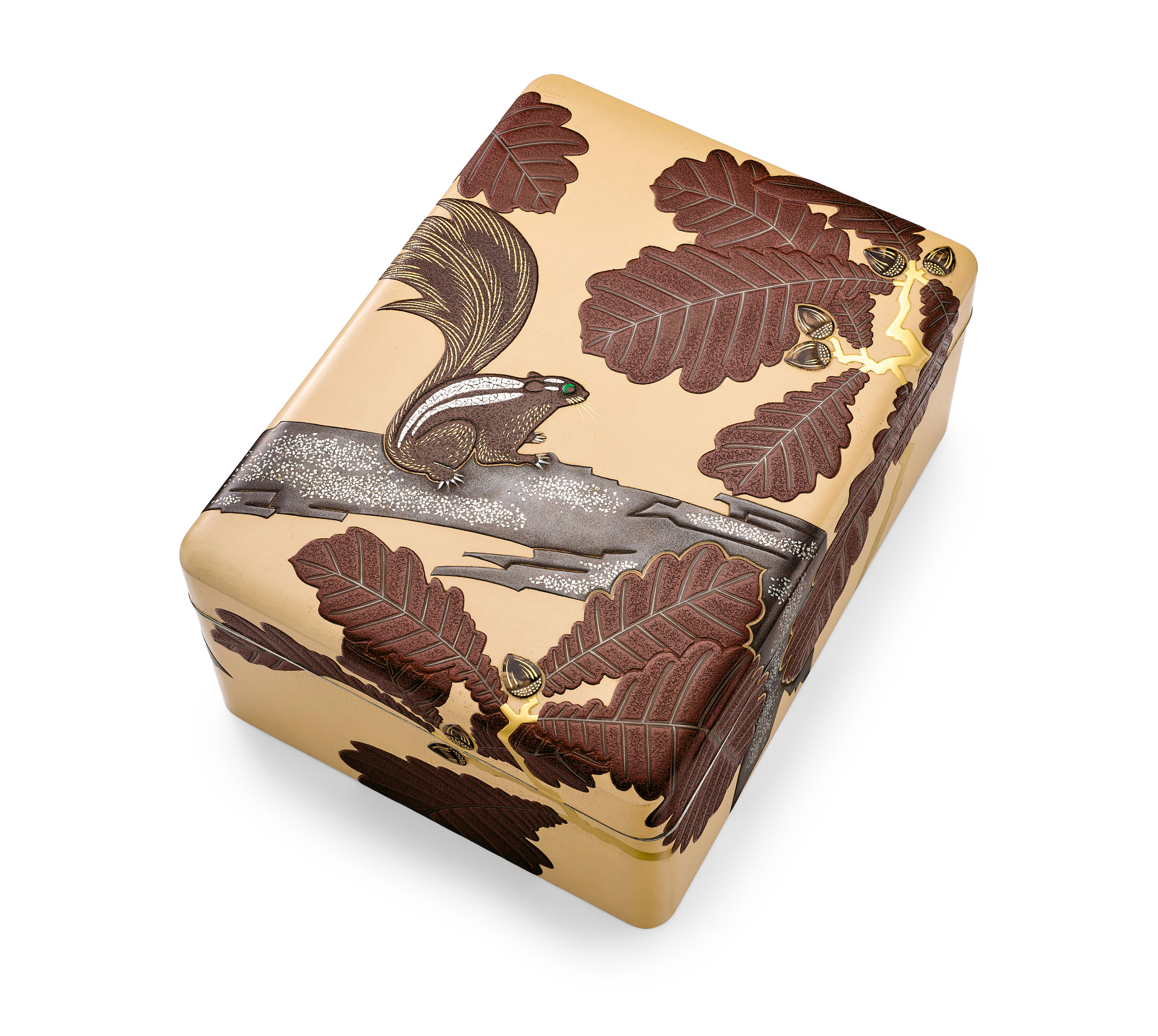A fine lacquer accessory box, Tebako Taisho Period (1912-1926) signed Akatsuka Jitoku and with kakihan (1871-1936) of rectangular shape with rounded corners designed on the cover and sides with peony-like flowers (shakuyaku) below an imperial sixteen-petal chrysanthemum medallion, the blossoms of purple and white created by pieces of inlaid shells and of gold lacquer and the leaves and veins of the leaves and stems of two colours of gold takamaki-e enriched by kimpun and okibirame, the chrysanthemum medallion kinji and the ground kimpun, the interior and base nashiji and the rims silver, signed on the interior of the cover -- 11in.x 9¼in.x 5¾in. (27.9cm.x 23.5cm.x 14.5cm.), in wood storage box, (minor surface scratching and wear). See Illustration, Detail of Signature and Front Cover. Literature: Jan Dees, "Japanese Imperial Presentation Boxes 1900-1930", Oriental Art, vol 43, no 1 (1997), pp 2-9; Dees, "Imperial lacquer boxes by Akatsuka Jitoku", Andon, 30 (1988), pp 103-110. Born in Tokyo, Akatsuka Jitoku was the seventh generation of a family of lacquer craftsmen. He studied maki-e with his father. In addition to this training in lacquer, however, he learned Nihonga painting from Kano Hisanobu and Terazaki Kogyo (1866-1919) and then went on to study Western-style painting at the Hakubakai Kenkyujo (the Institute of the White Horse Society)in 1912. As a result he was able to modernize his craft by adding an alluring element of Western naturalism to his otherwise very traditional, conservative lacquer techniques. He also worked hard to elevate lacquer into a category that would be included in the Teiten exhibitions. Jitoku won a gold medal at the 1904 Louisiana Purchase Exposition. He was active throughout the Taisho and early Showa periods not only as a leading lacquer artist but also as a judge at several kinds of exhibitions. In 1930 he was appointed Imperial Artist, a member of the elite Teikoku geijutsuin (the Imperial Art Academy). The first presentation boxes are thought to date from the turn of the 20th century and they are almost always adorned with large imperial chrysanthemum crests. There is a Jitoku box in the Royal Collection at Buckingham Palace which was given by Emperor Meiji to Queen Mary in 1911.
A fine lacquer accessory box, Tebako Taisho Period (1912-1926) signed Akatsuka Jitoku and with kakihan (1871-1936) of rectangular shape with rounded corners designed on the cover and sides with peony-like flowers (shakuyaku) below an imperial sixteen-petal chrysanthemum medallion, the blossoms of purple and white created by pieces of inlaid shells and of gold lacquer and the leaves and veins of the leaves and stems of two colours of gold takamaki-e enriched by kimpun and okibirame, the chrysanthemum medallion kinji and the ground kimpun, the interior and base nashiji and the rims silver, signed on the interior of the cover -- 11in.x 9¼in.x 5¾in. (27.9cm.x 23.5cm.x 14.5cm.), in wood storage box, (minor surface scratching and wear). See Illustration, Detail of Signature and Front Cover. Literature: Jan Dees, "Japanese Imperial Presentation Boxes 1900-1930", Oriental Art, vol 43, no 1 (1997), pp 2-9; Dees, "Imperial lacquer boxes by Akatsuka Jitoku", Andon, 30 (1988), pp 103-110. Born in Tokyo, Akatsuka Jitoku was the seventh generation of a family of lacquer craftsmen. He studied maki-e with his father. In addition to this training in lacquer, however, he learned Nihonga painting from Kano Hisanobu and Terazaki Kogyo (1866-1919) and then went on to study Western-style painting at the Hakubakai Kenkyujo (the Institute of the White Horse Society)in 1912. As a result he was able to modernize his craft by adding an alluring element of Western naturalism to his otherwise very traditional, conservative lacquer techniques. He also worked hard to elevate lacquer into a category that would be included in the Teiten exhibitions. Jitoku won a gold medal at the 1904 Louisiana Purchase Exposition. He was active throughout the Taisho and early Showa periods not only as a leading lacquer artist but also as a judge at several kinds of exhibitions. In 1930 he was appointed Imperial Artist, a member of the elite Teikoku geijutsuin (the Imperial Art Academy). The first presentation boxes are thought to date from the turn of the 20th century and they are almost always adorned with large imperial chrysanthemum crests. There is a Jitoku box in the Royal Collection at Buckingham Palace which was given by Emperor Meiji to Queen Mary in 1911.
.jpg)


.jpg)
.jpg)
.jpg)
.jpg)

.jpg)
.jpg)





Try LotSearch and its premium features for 7 days - without any costs!
Be notified automatically about new items in upcoming auctions.
Create an alert